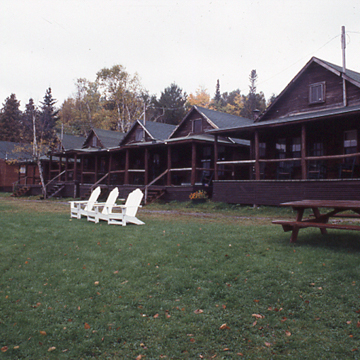Lakewood Camps is a typical Maine sporting camp located on Lower Richmond Lake in Middle Dam, near the New Hampshire border. It dates to 1910, somewhat late for an American cultural phenomenon that took root in the 1870s. Lakewood Camps embodies the essence of the sporting camp tradition. Reputed for its plentiful stock of salmon and trout, Lower Richmond Lake hosted three camps in the late 1870s, including a three-story Victorian Hotel built by the Androscoggin Transportation Company. The present Lakewood Camps, run since 1976 by Sue and Stan Milton, is seated on 1,600 acres and consists of twelve rustic cabins and a clubhouse. With few modifications, all thirteen of the camp structures have similar rustic features.
The Lakewood Camp cabins are single-story, three-bay, wood-frame structures sheathed with log (flat on the interior) or clapboard with an asphalt-shingled gable roof. All have front porches supported by rustic log posts and feature log railings and rocking chairs. Each cabin facade features a central door flanked by a single two-over-two, double-hung window, with another window piercing the front gable above the doorway. The cabins have wood-burning Franklin Stoves and sleep two to six guests, but do not have kitchens or dining rooms. The clubhouse or “dining room” is simply a much larger version of the cabins and contains the camp office and a spacious dining room with a large stone fireplace.
Derived from the late Victorian middle-class obsession with the wilderness and nature, the sporting camp was distinctive to Maine. Rapid industrialization on the East Coast stirred fears that urban culture in New York and other large cities was becoming effete, enfeebling, and bereft of vigor. A search for the “rugged life” ensued; returning to nature for most urbanites meant a hunting or fishing venture, at first in New York’s Adirondacks in the antebellum years, then in Maine after 1870. Increasingly, in the 1870s and 1880s these sporting trips were facilitated and promoted by rail lines such as the Maine Central and the Bangor and Aroostook Railroads, and publications such as Harper’s and Forest and Stream glorified the wonders of Maine’s woods. While camps in the Adirondacks were individually owned, Maine sporting camps were entrepreneurial complexes, typically one- or one-and-a-half-story log or frame structures flanking a main lodge where meals were served, which typically faced a lake or river. Elementary, rustic architecture with exposed interior beams, these lodges featured large stone fireplaces and trophy fish and deer heads for ornamentation.
This well-maintained camp continues to offer opportunities for fishing, hiking, canoeing, and kayaking.
References
Cole, Stephen A. Maine Sporting Camps: A Phase One Survey. Augusta: Maine Historic Preservation Commission, 1990. Maine Historic Preservation Library, Augusta, ME.
Wescott, Richard R. “Tourism in Maine.” In Maine: The Pine Tree State from Prehistory to the Present, edited by Richard W. Judd, Edwin A. Churchill and Joel W. Eastman. Orono: University of Maine Press, 1995.








